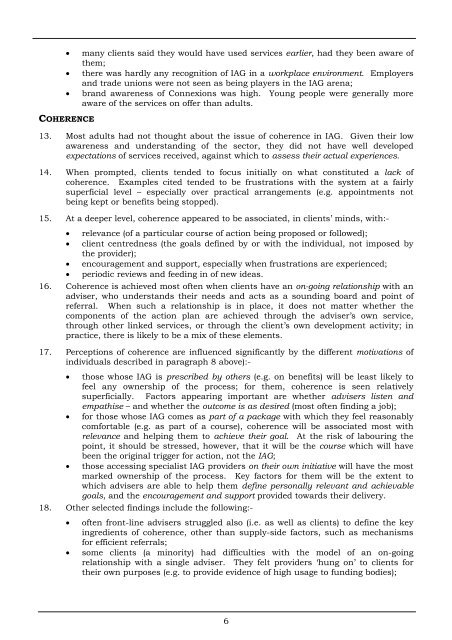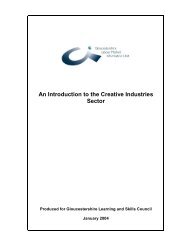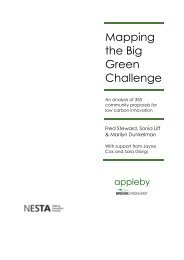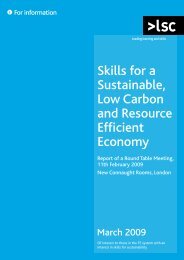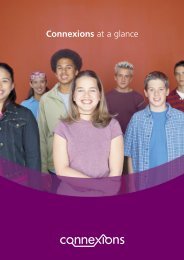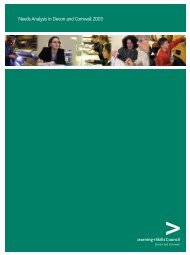Client needs for coherent information, advice and guidance services ...
Client needs for coherent information, advice and guidance services ...
Client needs for coherent information, advice and guidance services ...
You also want an ePaper? Increase the reach of your titles
YUMPU automatically turns print PDFs into web optimized ePapers that Google loves.
• many clients said they would have used <strong>services</strong> earlier, had they been aware of<br />
them;<br />
• there was hardly any recognition of IAG in a workplace environment. Employers<br />
<strong>and</strong> trade unions were not seen as being players in the IAG arena;<br />
• br<strong>and</strong> awareness of Connexions was high. Young people were generally more<br />
aware of the <strong>services</strong> on offer than adults.<br />
COHERENCE<br />
13. Most adults had not thought about the issue of coherence in IAG. Given their low<br />
awareness <strong>and</strong> underst<strong>and</strong>ing of the sector, they did not have well developed<br />
expectations of <strong>services</strong> received, against which to assess their actual experiences.<br />
14. When prompted, clients tended to focus initially on what constituted a lack of<br />
coherence. Examples cited tended to be frustrations with the system at a fairly<br />
superficial level – especially over practical arrangements (e.g. appointments not<br />
being kept or benefits being stopped).<br />
15. At a deeper level, coherence appeared to be associated, in clients’ minds, with:-<br />
• relevance (of a particular course of action being proposed or followed);<br />
• client centredness (the goals defined by or with the individual, not imposed by<br />
the provider);<br />
• encouragement <strong>and</strong> support, especially when frustrations are experienced;<br />
• periodic reviews <strong>and</strong> feeding in of new ideas.<br />
16. Coherence is achieved most often when clients have an on-going relationship with an<br />
adviser, who underst<strong>and</strong>s their <strong>needs</strong> <strong>and</strong> acts as a sounding board <strong>and</strong> point of<br />
referral. When such a relationship is in place, it does not matter whether the<br />
components of the action plan are achieved through the adviser’s own service,<br />
through other linked <strong>services</strong>, or through the client’s own development activity; in<br />
practice, there is likely to be a mix of these elements.<br />
17. Perceptions of coherence are influenced significantly by the different motivations of<br />
individuals described in paragraph 8 above):-<br />
• those whose IAG is prescribed by others (e.g. on benefits) will be least likely to<br />
feel any ownership of the process; <strong>for</strong> them, coherence is seen relatively<br />
superficially. Factors appearing important are whether advisers listen <strong>and</strong><br />
empathise – <strong>and</strong> whether the outcome is as desired (most often finding a job);<br />
• <strong>for</strong> those whose IAG comes as part of a package with which they feel reasonably<br />
com<strong>for</strong>table (e.g. as part of a course), coherence will be associated most with<br />
relevance <strong>and</strong> helping them to achieve their goal. At the risk of labouring the<br />
point, it should be stressed, however, that it will be the course which will have<br />
been the original trigger <strong>for</strong> action, not the IAG;<br />
• those accessing specialist IAG providers on their own initiative will have the most<br />
marked ownership of the process. Key factors <strong>for</strong> them will be the extent to<br />
which advisers are able to help them define personally relevant <strong>and</strong> achievable<br />
goals, <strong>and</strong> the encouragement <strong>and</strong> support provided towards their delivery.<br />
18. Other selected findings include the following:-<br />
• often front-line advisers struggled also (i.e. as well as clients) to define the key<br />
ingredients of coherence, other than supply-side factors, such as mechanisms<br />
<strong>for</strong> efficient referrals;<br />
• some clients (a minority) had difficulties with the model of an on-going<br />
relationship with a single adviser. They felt providers ‘hung on’ to clients <strong>for</strong><br />
their own purposes (e.g. to provide evidence of high usage to funding bodies);<br />
6


